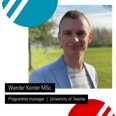During this session we'll look at several dillemma’s about the process of implementing your health innovation and push your innovation forward. Via several cases, our panel comprised of different experts with different background will discuss with the public which course the cases could take the ignite acceleration. The session is hands-on with interactive elements, different cases from different health application domains and a panel of experts. The session will conclude in the recent learnings and initiatives at the TechMed centre to help accelerating implementation. Together with healthcare professionals, patients, business and science, we as TechMed Centre want to improve the translation, adoption, safe and effective use of health technology. Come join us and discuss with us how TechMed can make the difference.
The programme
11.00 - 11.15 | Welcome & Introduction |
11.15 - 11.30 | Case 1 & panel discussion on best course to accelerate this case |
11.30 - 11.45 | Case 2 & panel discussion on best course to accelerate this case |
11.45 - 12.00 | Case 3 & panel discussion on best course to accelerate this case |
12.00 - 12.10 | Conclusion & closing words |
Case description 1: Christoff Heunis will introduce the audience to the ARMM (Advanced Robotics for Magnetic Manipulation) system developed at the Surgical Robotics Laboratory in the Biomechanical Engineering Department. This system is designed to improve procedures in interventional cardiology and is aiming to reduce operating times and hospitalization durations.
Dilemma: In the moment of finishing your preliminary work potentially bringing you a minimal viable product, but wanting to commercialize the technology, where do you start? What are the priorities and how can you continue?
Case description 2: added soon
Dilemma: added soon
Case description: Matthijs Noordzij will introduce the Sense-IT, a new bio-cueing technology framework. He will introduce challenges associated with prototype technology, which already requires a lot of human-technology interaction and associated technology stability/usability already in the initial phases of evaluation.
Dilemma: Guaranteeing stability of technology is expensive in wearables and applications; but investments are needed; What is sufficient evidence for a business case, get investors involved and when start with clinical testing and evaluating its added value?









